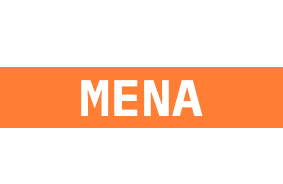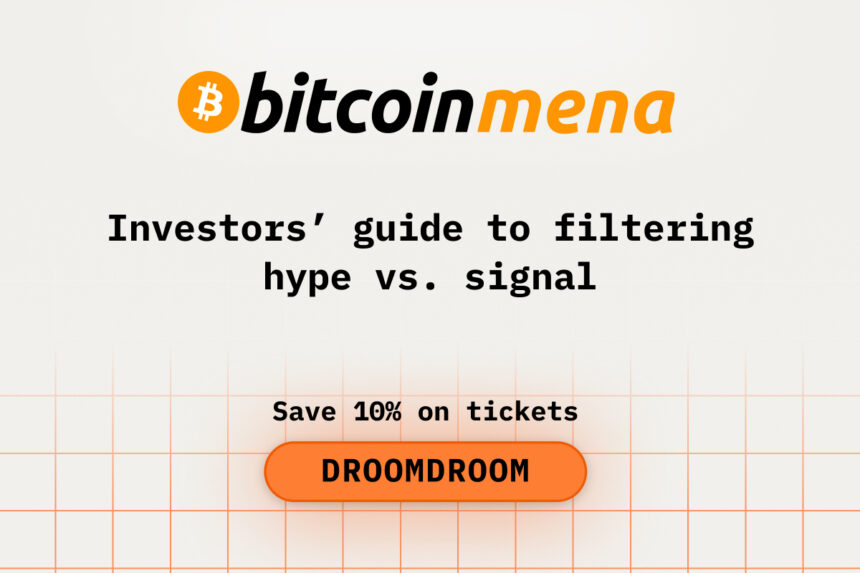Bitcoin MENA is one of the most anticipated events in the Saudi and wider Middle East crypto calendar. It brings together founders, engineers, projects, VCs, institutions, and media in an environment full of bold announcements, flashy marketing, prototype reveals, and speculative energy. As an investor, your goal should be to spot signal amidst all that noise. Which startups truly deserve attention, and which are riding hype? This guide provides tools, mindset shifts, and specific evaluation criteria to help you distinguish substance from showmanship at Bitcoin MENA. Before we dive in, here’s a tip to make sure you get in with some savings:
Book your Bitcoin MENA ticket at a 10% discount by entering the official promo code DROOMDROOM.
Understanding What Drives Hype
At a big conference, hype often comes through sheer visibility: keynote speakers, media coverage, social media buzz, big booths, influencer endoresements, or walking up with slick presentation decks. These are important for brand visibility, but they don’t always correlate with technical maturity or strong product fundamentals.
Some common hype signals include high-gloss marketing materials, vague claims of partnerships, dramatic roadmaps with many features, or promises of mass adoption without proof of product stability. Hype catches attention; signal earns trust. As an investor, looking beyond what is visible on the stage—and asking direct, detailed questions—often uncovers whether what you see is signal or just noise.
Key Signals Investors Should Prioritize
When you’re filtering for signal, these criteria are often more predictive of long-term success:
- Technical foundation: Is there a working prototype, testnet deployment, open-source code base, or active developer contribution?
- Team credibility: Founders with previous experience, especially in infrastructure, open source, or protocol engineering often fare better.
- User or developer traction: Early users, GitHub issues, pull requests, beta testers, or integrations are strong indicators of real usage.
- Clarity of roadmap & risk awareness: How do founders talk about scaling, fees, security, or regulatory risk? A strong team is transparent about trade-offs.
These are the kinds of signals that survive beyond the conference hype cycle.
Purchase your Bitcoin MENA ticket now and save 10% with the official promo code DROOMDROOM.
Questions That Reveal Signal vs. Hype
What you ask matters as much as what you see. Here are some questions that tend to force clarity:
- “Can you walk me through a recent bug or failure and how you fixed or plan to fix it?”
- “How have you stress-tested for network load, fee fluctuations, or block size constraints in Bitcoin?”
- “Which protocols or components are you relying on that are external dependencies—and have you audited or tested those?”
- “What is your current adoption: number of users, nodes, wallets, or other metrics—not Twitter followers?”
The responses to these often separate teams with solid track records from those with ambition but less technical stringency.
Beware Red Flags That Predict Short-Term Hype
Hype often shows up in certain recurring patterns. Unrealistically fast timelines (“launching in 3 months across multiple regions”), vague claims (“we will transform X industry”), or excessive reliance on promotional giveaways rather than core product quality are common red flags.
Also, pay attention if a project emphasizes quantity of visibility (celebrity endorsements, press announcements) more than product demos or technical backlogs. If gloss outweighs depth, it’s likely more hype than signal.
Enjoy 10% savings on Bitcoin MENA tickets by applying the official promo code DROOMDROOM.
Use Conference Design & Side Events to Spot Signal
Not all value is delivered on the main stage. Workshops, breakout sessions, developer labs, panel discussions, and informal mixers are where founders show humility, technical constraints, and community feedback. Observing how a founder responds under pressure, fields tough questions, or handles technical detail in smaller settings is often more revelatory than main stage polished speeches.
Booth demos are also useful: ask for live demos rather than just pitch videos; see how stable the product is when you interact with it; ask about bug history. These hands-on moments can give you clues about engineering discipline.
Post-Conference Follow-Through: Where Signal Becomes Clear
An important part of distinguishing signal comes after the event. Track which startups follow through on what they promised: do they publish code? release updates? fix bugs? build integrations? Startups with staying power maintain consistency in communication, product roadmap, and respond to community feedback.
Also, follow up conversations with meaningful value: perhaps share constructive feedback, offer connections, or test their product yourself and give feedback. Teams that welcome critique, iterate publicly, and demonstrate transparent progress are historically more reliable investments.
Grab 10% off your Bitcoin MENA ticket instantly with the official promo code DROOMDROOM.
Balancing Risk and Reward
Signal often requires investing through uncertainty: regulatory risk, technical risk, and adoption risk. As an investor, clarify your tolerance: are you okay backing pre-revenue teams? Do you favor startups solving deep protocol or infrastructure vs consumer layer? Assess how much risk is acceptable for you and use that lens when evaluating claims.
Keep in mind that signal often emerges over months or years, not just during and immediately after the conference.
Conclusion
Filtering hype vs. signal at Bitcoin MENA takes more than just keen eyes—it requires disciplined scrutiny, technical empathy, and strategic follow-up. By focusing on technical foundation, team credibility, adoption metrics, roadmap clarity, and observing behavior beyond the marketing shine, you’re much more likely to find startup opportunities with real potential.

















